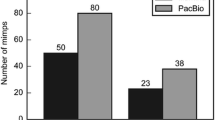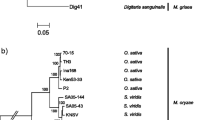Abstract.
We investigated a DNA fragment and its flanking region deleted in the spontaneous Pi-a virulent mutant of Magnaporthe grisea Ina168. A new transposon-like sequence was identified from a region adjacent to the deleted fragment and was named Occan. Occan contained a 2,259-bp ORF interrupted by one 63-bp intron and had both a TA dinucleotide and 77 bp of perfect inverted repeats at both termini, without direct repeats. These features indicated that Occan is a member of the Fot1 family. RT-PCR analysis confirmed the expression of the putative transposase and the presence of an intron. Southern analysis of pulse-field gel electrophoresis-separated chromosomes indicated that Occan was dispersed in all chromosomes of the rice pathogen, Ina168. Copy numbers of Occan were also preserved in a host-specific manner amongst M. grisea isolates. In particular, rice pathogens contained a large number of the element inserted into their genome. Phylogenetic analysis with other known members of the Fot1 family revealed that Occan was dissimilar to any other known elements and it is thus proposed that Occan be separated to a new subfamily.







Similar content being viewed by others
References
Altschul SF, Madden TL, Schaffer AA, Zhang J, Zhang Z, Miller W, Lipman DJ (1997) Gapped BLAST and PSI-BLAST: a new generation of protein database search programs. Nucleic Acids Res 25:3389–3402
Ballance DJ (1986) Sequences important for gene expression in filamentous fungi. Yeast 2:229–236
Daboussi MJ (1997) Fungal transposable elements and genome evolution. Genetica 100:253–260
Daboussi MJ, Langin T, Brygoo Y (1992) Fot1, a new family of fungal transposable elements. Mol Gen Genet 232:12–16
Dobinson KF, Harris RE, Hamer JE (1993) Grasshopper, a long terminal repeat (LTR) retroelement in the phytopathogenic fungus Magnaporthe grisea. Mol Plant-Microbe Interact 6:114–126
Enkerli J, Bhatt G, Covert SF (1997) Nht1, a transposable element cloned from a dispensable chromosome in Nectria haematococca. Mol Plant-Microbe Interact 10:742–749
Farman ML, Tosa Y, Nitta N, Leong SA (1996a) MAGGY, a retrotransposon in the genome of the rice blast fungus Magnaporthe grisea. Mol Gen Genet 251:665–674
Farman ML, Taura S, Leong SA (1996b) The Magnaporthe grisea DNA fingerprinting probe MGR586 contains the 3' end of an inverted repeat transposon. Mol Gen Genet 251:675–681
Farman ML, Eto Y, Nakao T, Tosa Y, Nakayashiki H, Mayama S, Leong SA (2002) Analysis of the structure of the AVR1-CO39 avirulence locus in virulent rice-infecting isolates of Magnaporthe grisea. Mol Plant-Microbe Interact 15:6–16
Fukiya S, Kodama M, Kito H, Sone T, Tomita F (2001) Establishment of a new cross of the rice blast fungus derived from Japanese differential strain Ina168 and hermaphroditic rice pathogen Guy11. Biosci Biotechnol Biochem 65:1464–1473
Hamer JE, Farrall L, Orbach MJ, Valent B, Chumley FG (1989) Host species-specific conservation of a family of repeated DNA sequences in the genome of a fungal plant pathogen. Proc Natl Acad Sci USA 86:9981–9985
Kachroo P, Leong SA, Chattoo BB (1994) Pot2, an inverted repeat transposon from the rice blast fungus Magnaporthe grisea. Mol Gen Genet 245:339–348
Kachroo P, Leong SA, Chattoo BB (1995) Mg-SINE: a short interspersed nuclear element from the rice blast fungus, Magnaporthe grisea. Proc Natl Acad Sci USA 92:11125–11129
Kang S (2001) Organization and distribution pattern of MGLR-3, a novel retrotransposon in the rice blast fungus Magnaporthe grisea. Fungal Genet Biol 32:11–19
Kang S, Lebrun MH, Farrall L, Valent B (2001) Gain of virulence caused by insertion of a Pot3 transposon in Magnaporthe grisea avirulence gene. Mol Plant-Microbe Interact 14:671–674
Kempken F, Kück U (1996) restless, an active Ac-like transposon from the fungus Tolypocladium inflatum: structure, expression, and alternative RNA splicing. Mol Cell Biol 16:6563–6572
Kempken F, Kück U (1998) Transposons in filamentous fungi—facts and perspectives. BioEssays 20:652–659
Kempken F, Kück U (2000) Tagging of a nitrogen pathway-specific regulator gene in Tolypocladium inflatum by the transposon Restless. Mol Gen Genet 263:302–308
Kimura M, Ymaguchi I (1998) Convergent transcription units and their promoters at both ends of Pot2, an inverted repeat transposon from the rice blast fungus. J Biochem 124:268–273
Levis C, Fortini D, Brygoo Y (1997) Flipper, a mobile Fot1-like transposable element in Botrytis cinerea. Mol Gen Genet 254:674–680
Migheli Q, Laugé R, Davière JM, Gerlinger C, Kaper F, Langin T, Daboussi MJ (1999) Transposition of the autonomous Fot1 element in the filamentous fungus Fusarium oxysporum. Genetics 151:1005–1013
Nakayashiki H, Matsuo H, Chuma I, Ikeda K, Betsuyaku S, Kusaba M, Tosa Y, Mayama S (2001) Pyret, a Ty3/Gypsy retrotransposon in Magnaporthe grisea contains an extra domain between the nucleocapsid and protease domains. Nucleic Acids Res 29:4106–4113
Nishimura M, Hayashi N, Jwa NS, Lau GW, Hamer JE (2000) Insertion of the LINE retrotransposon MGL causes a conidiophore pattern mutation in Magnaporthe grisea. Mol Plant-Microbe Interact 13:892–894
Nyyssönen E, Amutan M, Enfield L, Stubbs J, Dunn-Coleman NS (1996) The transposable element Tan1 of Aspergillus niger ver. awamori, a new member of the Fot1 family. Mol Gen Genet 253:50–56
Orbach MJ (1994) A cosmid with a HyR marker for fungal library construction and screening. Gene 150:159–162
Orbach MJ, Chumley FG, Valent B (1996) Electrophoretic karyotypes of Magnaporthe grisea pathogens of diverse grasses. Mol Plant-Microbe Interact 9:261–271
Panaccione DG, Pitkin JW, Walton JD, Annis SL (1996) Transposon-like sequences at the TOX2 locus of the plant-pathogenic fungus Cochliobolus carbonum. Gene 176:103–109
Pöggeler S (1997) Sequence characteristics within nuclear genes from Sordaria macrospora. Fungal Genet Newsl 44:41–44
Robertson HM (1996) Members of the pogo superfamily of DNA-mediated transposons in the human genome. Mol Gen Genet 252:761–766
Rossman AY, Howard RJ, Valent B (1990) Pyricularia grisea, the correct name for the rice blast disease fungus. Mycologia 82:509–512
Sambrook J, Fritsch EF, Maniatis T (1989) Molecular cloning, a laboratory manual, 2nd edn. Cold Spring Harbor Laboratory Press, Cold Spring Harbor, N.Y.
Shull V, Hamer JE (1996) Rearrangements at a DNA-fingerprint locus in the rice blast fungus. Curr Genet 30:263–271
Sone T, Suto M, Tomita F (1993) Host species-specific repetitive DNA sequence in the genome of Magnaporthe grisea, the rice blast fungus. Biosci Biotechnol Biochem 57:1228–1230
Sone T, Abe T, Suto M, Tomita F (1997) Identification and characterization of a karyotypic mutation in Magnaporthe grisea. Biosci Biotechnol Biochem 61:81–86
Talbot NJ, Salch YP, Ma M, Hamer JE (1993) Karyotypic variation within clonal lineages of the rice blast fungus, Magnaporthe grisea. Appl Environ Microbiol 59:585–593
Talbot NJ, MaCafferty HRK, Ma M, Moore K, Hamer JE (1997) Nitrogen starvation of the rice blast fungus Magnaporthe grisea may act as an environmental cue for disease symptom expression. Physiol Mol Plant Pathol 50:179–195
Thompson JD, Higgins DG, Gibson TJ (1994) CLUSTAL W: improving the sensitivity of progressive multiple sequence alignment through sequence weighting, positions-specific gap penalties and weight matrix choice. Nucleic Acids Res 22:4673–4680
Van Luenen HGAM, Colloms SD, Plasterk RHA (1994) The mechanism of transposition of Tc3 in C. elegans. Cell 79:293–301
Villalba F, Lebrun MH, Hua-Van A, Daboussi MJ, Grosjean-Cournoyer MC (2001) Transposon impala, a novel tool for gene tagging in the rice blast fungus Magnaporthe grisea. Mol Plant-Microbe Interact 14:308–315
Wang H, Hartswood E, Finnegan DJ (1999) Pogo transposase contains a putative helix-turn-helix DNA binding domain that recognises a 12 bp sequence within the terminal inverted repeats. Nucleic Acids Res 27:455–461
Acknowledgements.
We are grateful to four researchers for supplying fungal strains used in this study: Dr. Jean Loup Notteghem (Center de Coopération Internationale en Recherche Agronomique pour le Devéloppement/CA, Montpellier, France), Dr. Masataka Iwano (Hokuriku Department of Lowland Farming, National Agricultural Research Center, Niigata, Japan), Dr. Hiroshi Yaegashi (Saga University, Saga, Japan), and Dr. Shigehisa Kiyosawa. We also thank Dr. Takashi Kamakura (Laboratory of Chemical Genetics, The Institute of Physical and Chemical Research, Saitama, Japan) for technical advice on the preparation of HMW genomic DNA and for comments on the manuscript; and we thank Dr. Daniel J. Ebbole (Department of Plant Pathology and Microbiology, Texas A&M University, Tex., USA) for kindly giving us permission to use nucleotide sequences of ESTs (mgns001×H03f.b, mgns007×M18f.b).
Author information
Authors and Affiliations
Corresponding author
Additional information
Communicated by U. Kück
Rights and permissions
About this article
Cite this article
Kito, H., Takahashi, Y., Sato, J. et al. Occan, a novel transposon in the Fot1 family, is ubiquitously found in several Magnaporthe grisea isolates. Curr Genet 42, 322–331 (2003). https://doi.org/10.1007/s00294-002-0365-0
Received:
Revised:
Accepted:
Published:
Issue Date:
DOI: https://doi.org/10.1007/s00294-002-0365-0




